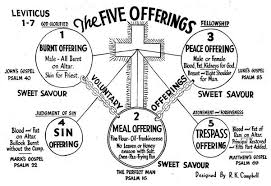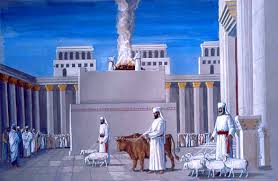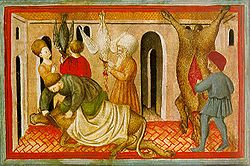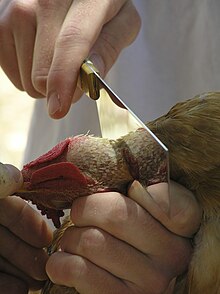A burnt offering in Judaism (Hebrew: קָרְבַּן עוֹלָה, korban olah), is a form of sacrifice first described in the Hebrew Bible.
In Temple, the burnt offering was a twice-daily animal sacrifice offered on the altar in thet temple in Jerusalem that was completely consumed by fire. The skin of the animal, however, was not burnt but given to the priests respective of their priestly division. These skins are listed as one of the twenty-four priestly gifts in Tosefta Hallah.
Shechita slaughter of a chicken
http://www.jewishencyclopedia.com/articles/3847-burnt-offering
The ordinary translation in modern versions of the Hebrew "'olah" ( ). This term does not mean literally "burnt offering," but "what is brought up" or presented to the Deity. The name is a translation of the Septuagint rendering, which is itself based upon the descriptive phrase often attached to "'olah" in the ritual prescriptions: "an offering made by fire unto the Lord" (Lev. i. 9 et seq.). A synonym is
). This term does not mean literally "burnt offering," but "what is brought up" or presented to the Deity. The name is a translation of the Septuagint rendering, which is itself based upon the descriptive phrase often attached to "'olah" in the ritual prescriptions: "an offering made by fire unto the Lord" (Lev. i. 9 et seq.). A synonym is , which defines the offering as complete; i.e., when it is placed upon the altar, to distinguish it from the other forms of animal sacrifice (see I Sam. vii. 9; compare Ps. li. 21). The burnt offering was the highest order of sacrifice in the Old Testament ritual. The bloodless offerings were made only in connection with it.
, which defines the offering as complete; i.e., when it is placed upon the altar, to distinguish it from the other forms of animal sacrifice (see I Sam. vii. 9; compare Ps. li. 21). The burnt offering was the highest order of sacrifice in the Old Testament ritual. The bloodless offerings were made only in connection with it.




In Temple, the burnt offering was a twice-daily animal sacrifice offered on the altar in thet temple in Jerusalem that was completely consumed by fire. The skin of the animal, however, was not burnt but given to the priests respective of their priestly division. These skins are listed as one of the twenty-four priestly gifts in Tosefta Hallah.
http://www.jewishencyclopedia.com/articles/3847-burnt-offering
The ordinary translation in modern versions of the Hebrew "'olah" (
Shechita
From Wikipedia, the free encyclopedia
(Redirected from Shechitah)

A 15th-century depiction of shechita andbedikah. It should be noted that the artist erroneously depicted knives with points at the tip, which are not acceptable for shechitah slaughter.
| |
| Halakhic texts relating to this article | |
|---|---|
| Torah: | Deuteronomy 12:21,Deuteronomy 14:21,Numbers 11:22 |
| Babylonian Talmud: | Chullin |
| Mishneh Torah: | Sefer Kodashim, Hilchot shechita |
| Shulchan Aruch: | Yoreh De'ah 1:27 |
| Other rabbinic codes: | Sefer ha-Chinuchmitzvah 451 |
The Hebrew term shechita (anglicized: /ʃəxiːˈtɑː/; Hebrew: שחיטה, [ʃχiˈta]), also transliterated shehitah, shechitah, shehita, means the slaughtering of certain mammals and birds for food according to Jewish dietary laws (Deut. 12:21, Deut. 14:21, Num. 11:22
The Hebrew noun olah (עֹלָה) occurs 289 times in the Masoretic Text of the Hebrew Bible. It means "that which goes up [in smoke]".[2] It is formed from the active participle of theHiphil form of the verb alah (עָלָה), "to cause to ascend." It was sometimes also called kalil, an associated word found in Leviticus, meaning "entire".[2][3]
Its traditional name in English is "holocaust",[2] and the word olah has traditionally been translated as "burnt offering."[3][4][5] The term was translated as holocauston in theSeptuagint. Today, some English Bible translations render the word as holocaust, and others translate it as "burnt offering". For example, Exodus 18:12a is translated in the New American Bible as Then Jethro, the father-in-law of Moses, brought a holocaust and other sacrifices to God, while it is translated in the New International Version as Then Jethro, Moses' father-in-law, brought a burnt offering and other sacrifices to God.
Hebrew Bible[edit]
The first uses of the olah for burnt offering refer to the sacrifices of Noah "of every clean beast, and of every clean fowl, and offered burnt offerings on the altar" (Genesis 8:20) and to the near-sacrifice of Isaac by Abraham: "offer him there for a burnt offering upon one of the mountains" (Genesis 22:22). The third pre-Levitical burnt offering is that ofJethro, Moses' father in law (Exodus 18:12).
In the Law of Moses[edit]
The source of the commandment as part of the Law of Moses is stated in Exodus 20:24, after the ten commandments:
. The law's requirements are further detailed in Numbers 28:1-8:
The lambs were to be offered in the morning and at twilight.[8] The actual ritual slaughter of the lamb was prescribed in Leviticus:
The twice-daily korban olah was accompanied by a wine offering poured into the altar (Numbers 28). Additionally, cumulative korban olah offerings were made on the Sabbath,[9]the first day of each month,[10] at Jewish New Year,[11] Passover,[12] First Fruits,[13] the Day of Atonement [14] and the Feast of Tabernacles.[15] The sacrificial animals were required to be bulls, rams, goats (as sin offerings) and lambs.
Multiple forms of offering[edit]
A korban olah was also made as a sin offering on the appointment of a priest,[16] on the termination of a Nazirite's vow, after recovery from skin disease, by a woman afterchildbirth, after recovery from a state of abnormal bodily discharges, a Gentile's conversion to Judaism or as a voluntary sacrifice, when the sacrificial animal could be a youngbull, ram, year-old goat, turtle doves, or pigeons.



No comments:
Post a Comment